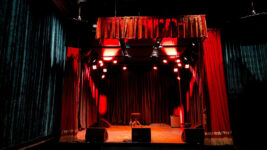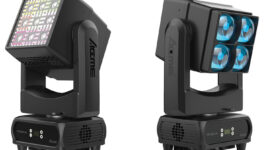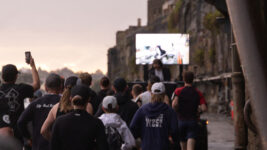THEATRE
15 Nov 2023
MANIFESTO
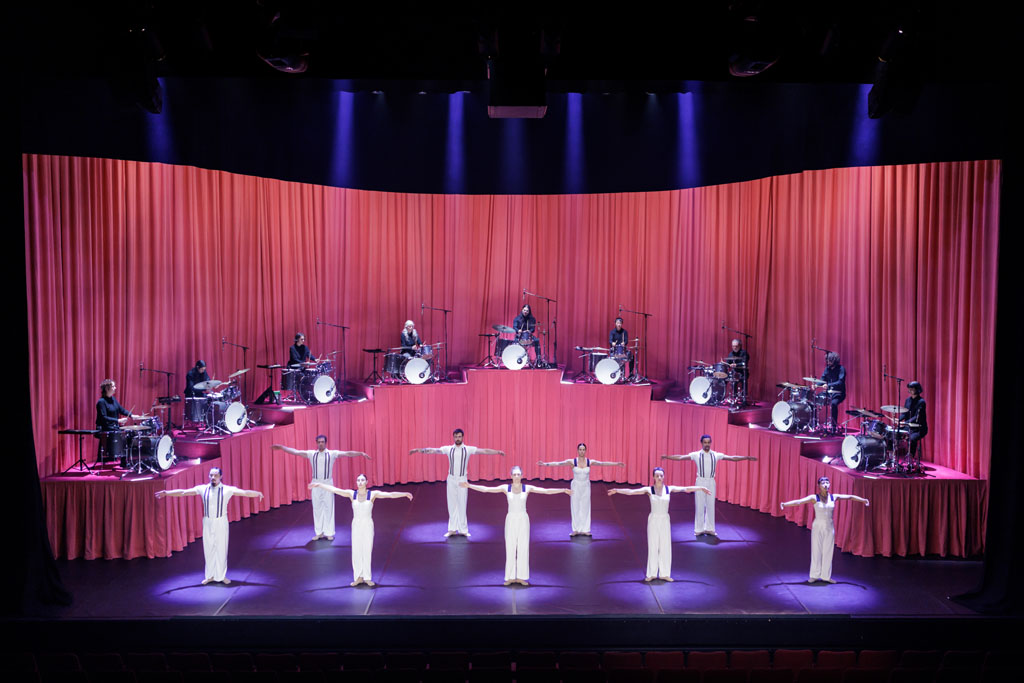
Subscribe to CX E-News
Stephanie Lake Company’s ‘Manifesto’ features nine virtuosic contemporary dancers set to a dynamic, pulsing, percussive score, performed live by nine drummers. The show has toured Australia’s major arts festivals since 2022 and following a sold-out season at the Ruhr Festival, Germany, it returned to Arts Centre Melbourne in late October 2023.
Having heard about the development of Manifesto in April 2021, I approached composer Robin Fox about working on the show. Robin and I have a long work history together in various music ensembles and making records together. I have also previously worked with choreographer Stephanie Lake, back when she was dancing with Chunky Move.
Robin’s score doesn’t include what you’d associate as traditional harmonic or melodic instruments. The live percussive soundtrack performed by nine drummers (all playing identical drum kits) manages to seamlessly weave its way through a multitude of sonic textures, mirroring the transformation and evolution of the choreography. It’s a captivating 60 minutes.
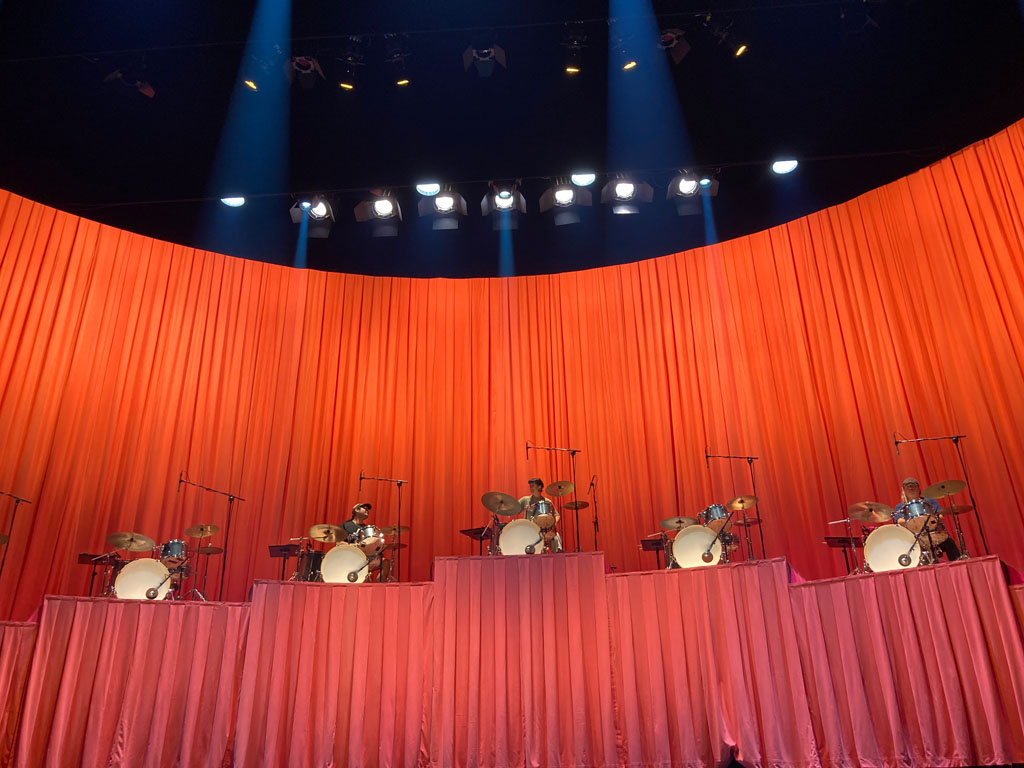
Robin explains; “Given that percussion is so broad that it can literally encompass any sound, I decided to limit the resources to identical standard drum kits. The one exception is the cymbals. I wanted to create harmonically complex textural washes so each drummer brings their signature in that regard. The real challenge then, was making an hour- long score with these sonic limitations in place. To me composition is about the concertina of energy over time, and I feel like I approached some sections quite electronically, focusing on the drone-like potential to counterbalance the more obvious rhythmic impulsion.”
The nine silver Premier drum kits are positioned on individual tiered staging that curves around behind the dancers. Set Designer Charles Davis has created a lavish pink playground that wraps around the stage, it is both impressive without being overwhelming. The set’s mass of pink colour contrasts the dancer’s unique white costumes by designer Paula Levis. Drummers, seated behind, wear characteristic black.
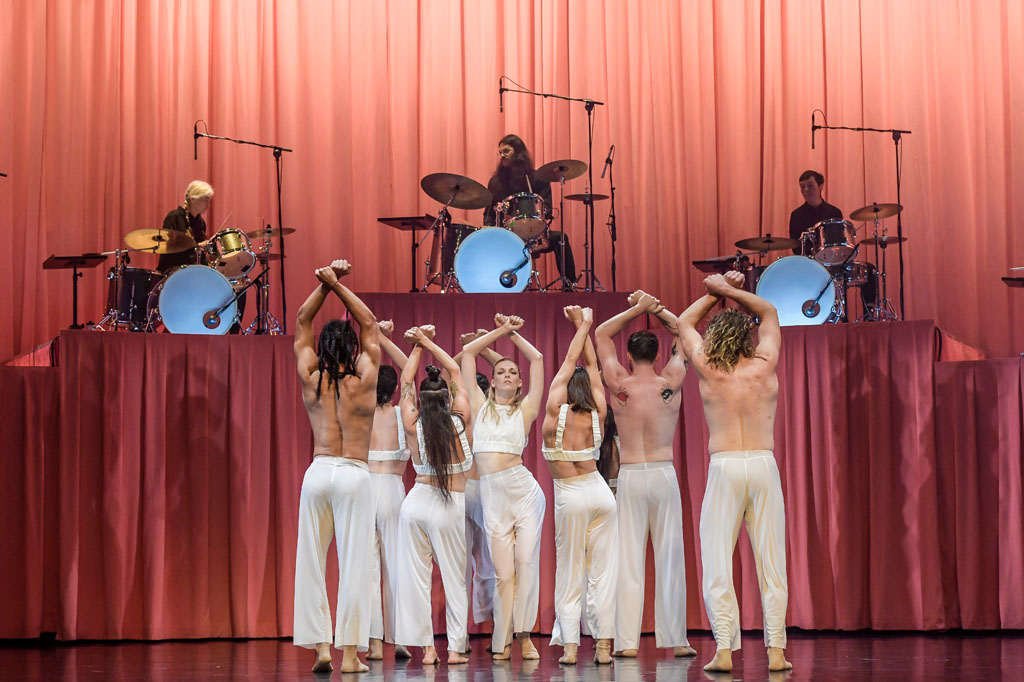
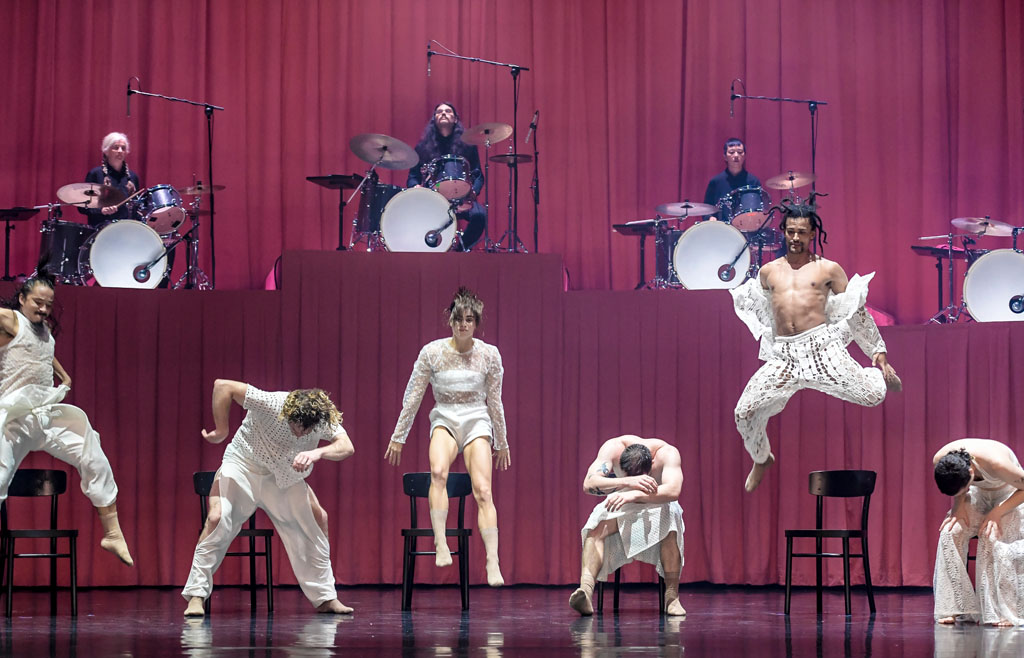
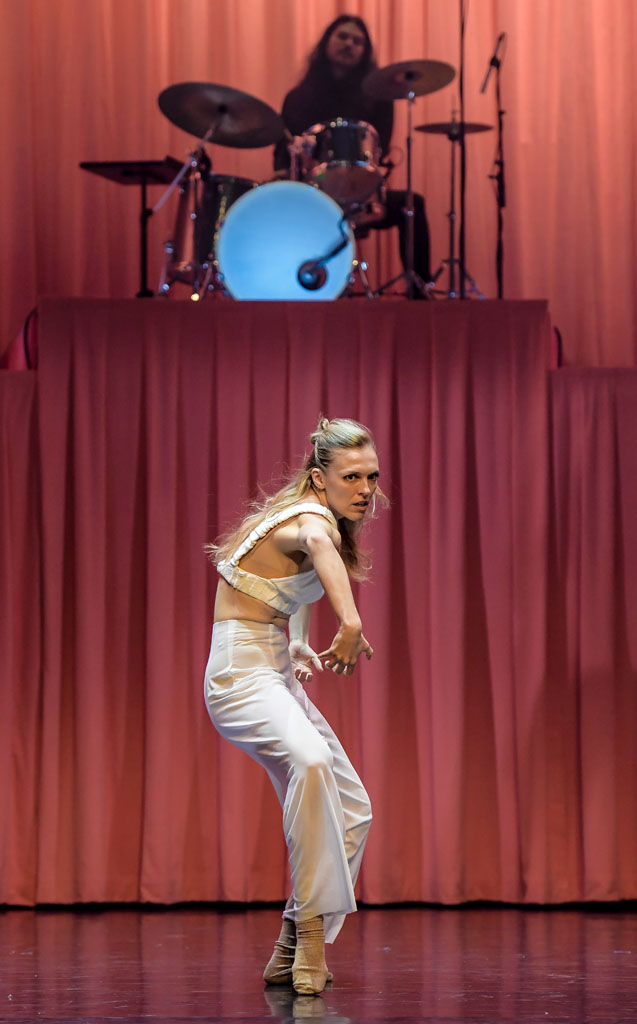
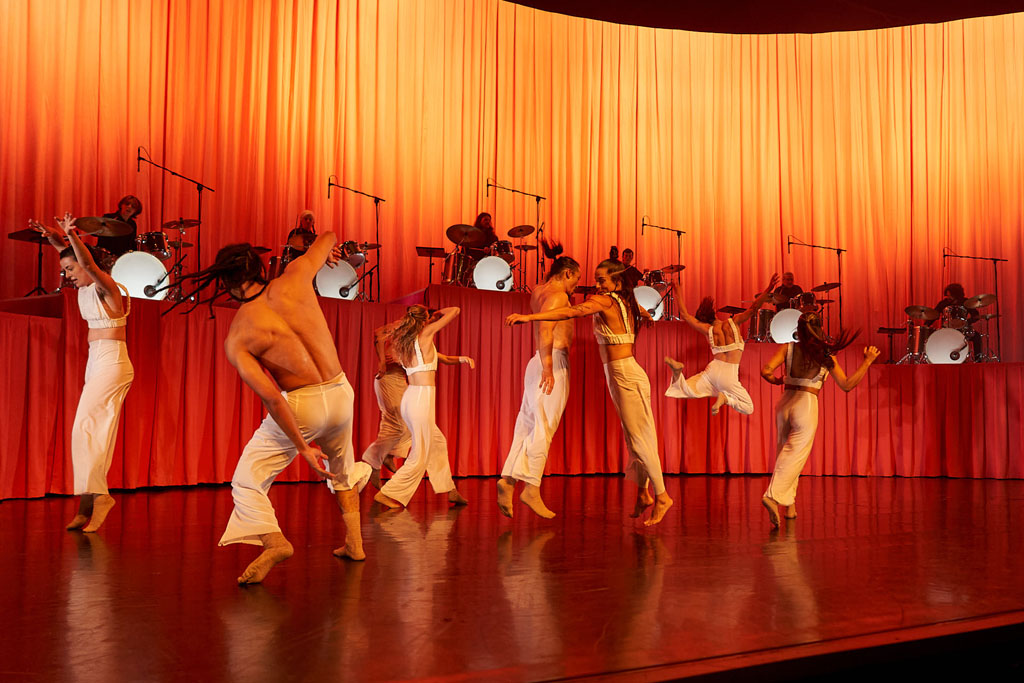
Lighting design is by Bosco Shaw from Additive Lighting, who worked with lighting operator Rachel Lee developing the show. The lighting design comprises 118 fixtures including ETC Source4, Selecon Pacific Zoom Spots and Martin MAC Viper Performance moving lights. Bosco took an open approach as the set’s massive pink drapery “came with some real challenges when trying to balance the light between the dancers and the drummers. Our solution uses some custom LED strip drum footlights, MH6s from above and some tightly focussed front light, which we had to add during tech week. The movers in the rig allow us to really focus in on some key choreographic moments, then open out to the entire stage for the bigger moments”. There are also sections of the show with sound activated lighting cues; these cues respond to the music’s dynamics by employing VDMX software to convert analogue audio signals to DMX.
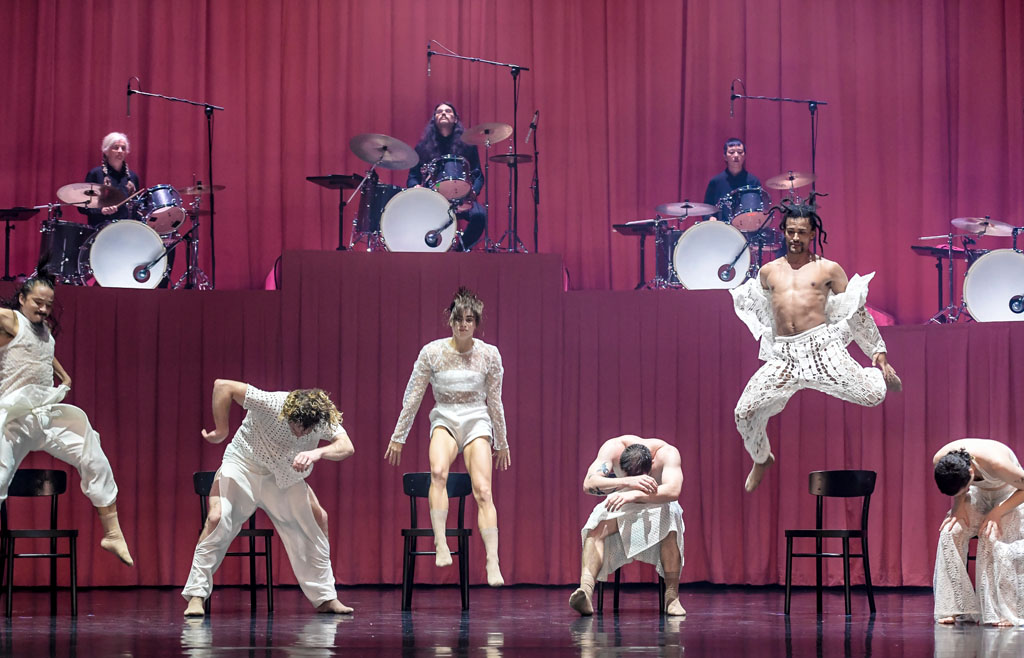
Rachel Lee operates the lighting cues using QLab software. QLab controls the ETC Eos Gio lighting console via OSC (Open Sound Control). QLab also sends cues to the audio console, triggering a total of 14 snapshots via MIDI. These snapshots are used to transition the DiGiCo SD12 audio console from one musical section to the next. QLab also plays back the click track and spoken cues to keep the drummers playing in time. 10 individual output sends are sent to the In Ear Monitor (IEMs) console over Dante or UB Madi – depending on what is available. A venue technician will operate the monitor console. Monitor consoles are venue dependant, usually a DiGiCo or Yamaha console, with their own digital stage boxes and analogue splitter if needed. I mix the show positioned in the venue with the audience and prefer the SD12 for operation as it has two screens and a dedicated master fader.
The mix is in stereo and any additional centre or stage speaker fills are added, subject to the venue’s needs. Subwoofers are often supplemented to an existing system to add low frequency impact. We try to specify a larger sound system, but budget doesn’t always allow it. We have used different point source and line array sound systems including JBL Vertec, L-Acoustics KARA and Meyer Sound Panther. Fundamentally we want to have control of the show’s dynamics and ensure clarity and uniformity across the venue. I would rate the sound system rig choice, positioning and timing as the most important component, above mics and console choice. I spend more time adjusting venue PAs in operation than I do worrying about mics and reverbs. With quick turnarounds for this show, a good system technician is invaluable to sort any PA issues you might be hearing.

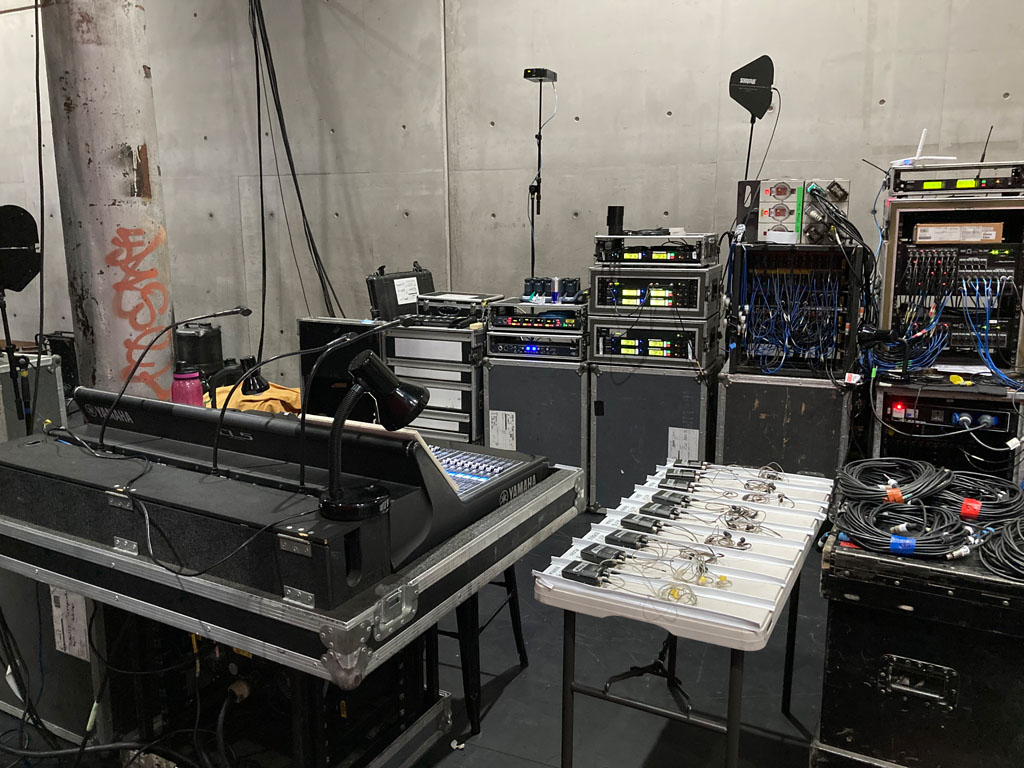
The imposing staging used in Australia is purpose built for the show, and embraced by a custom curved curtain rack from which hangs the opulent pink curtains. When touring internationally, standard staging and curtain rails are used to reduce freight costs and install times. The lowest stepped stages are 1200mm, up to a height of 2400mm, which makes for very high drum risers indeed. Upon the staging are nine identical silver Premier drum kits, all tuned to similar pitch. Drummers provide their own cymbals and sticks and remain seated throughout the performance.
If you choose any nine drummers they will likely all tune their drums differently. Kits will also go out of tune in different ways for a multitude of reasons, therefore we use a professional drum tuner at the start of every season. I also check before every show all the drum kit tunings and will talk to drummers about their kit sound if we need to make adjustments.
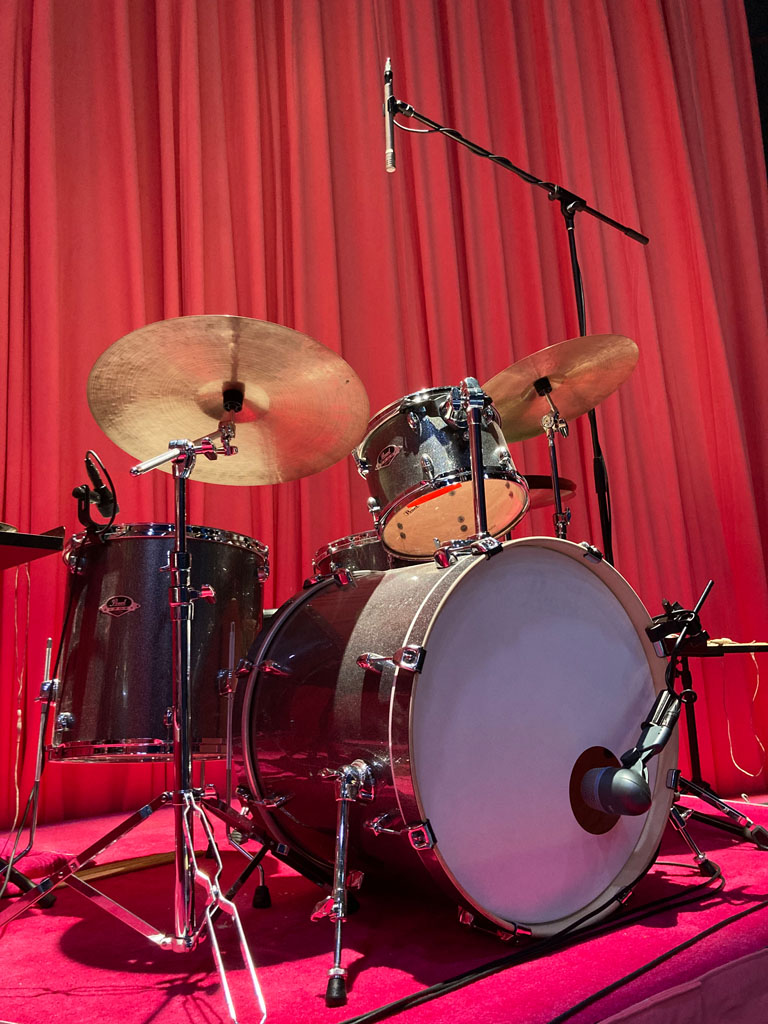
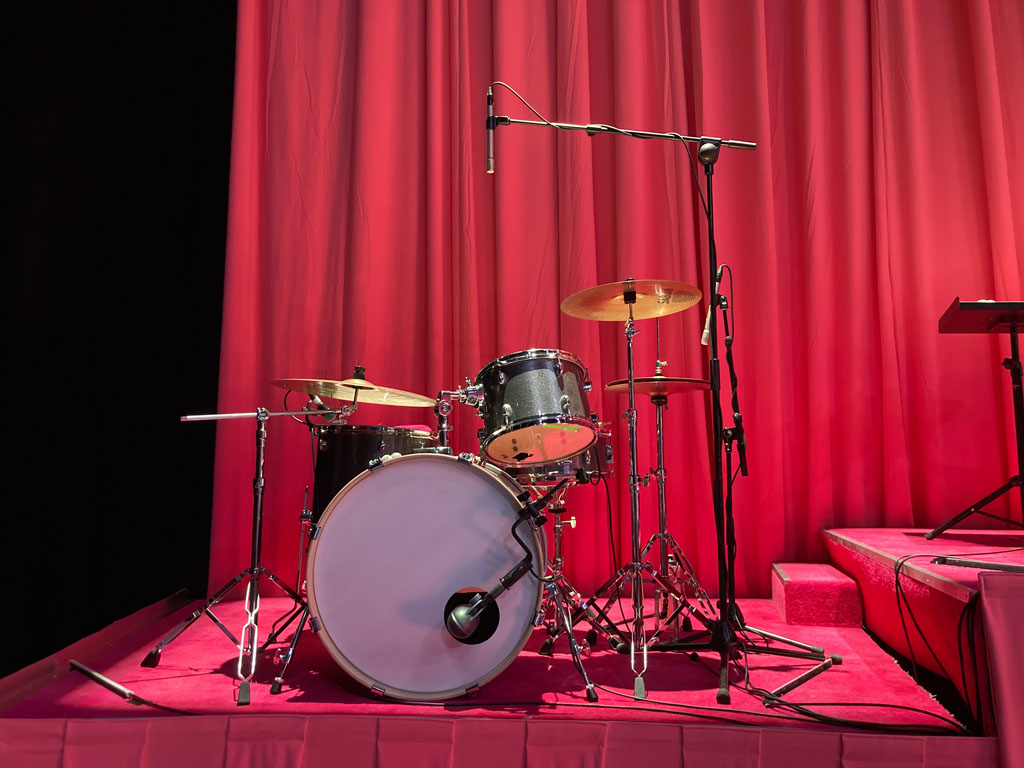
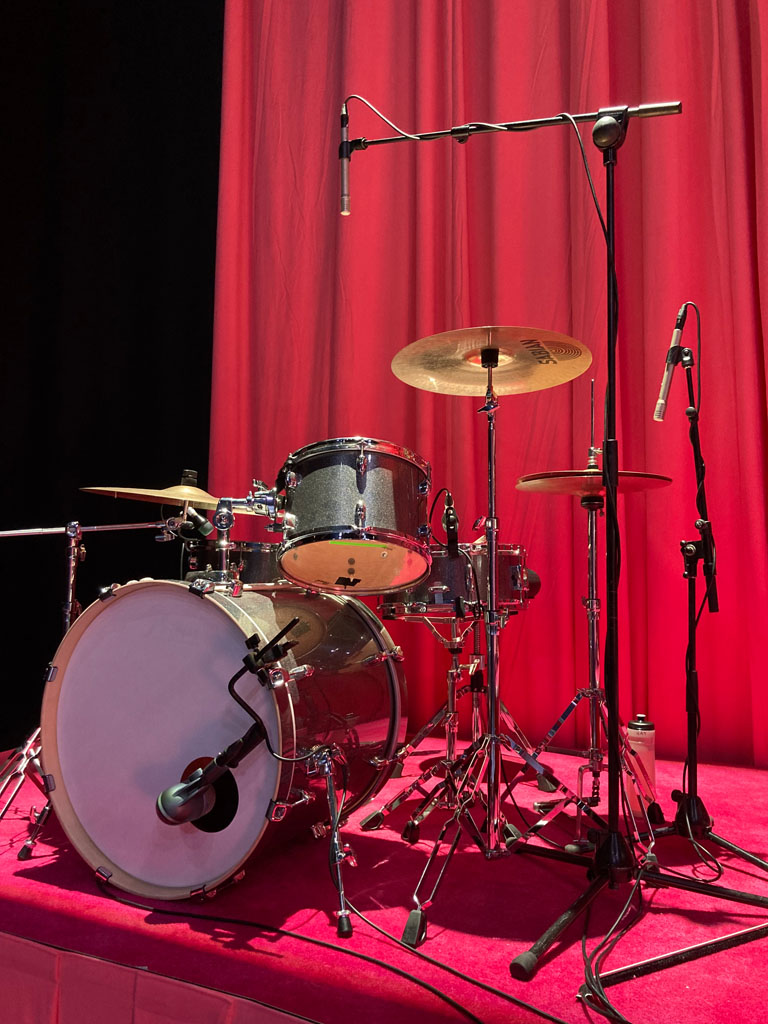
We have come to use a lot of dampening on the skins as any drum resonances are noticeable when close mic-ed, and this effect is worsened when multiplied across the nine kits. Moon gels, rings, tape and other improvised approaches (have you tried cotton wool balls in your floor tom?) are used to try and tame any lingering harmonics which has led to very dead sounding drum kits, which is not something I would have expected, but in this music context the slow decay of drum resonances has proven to be unwanted.
The music score is varied. It moves from loud drum solos to soft harmonic overtones agitated by sticks rubbing on the floor toms. A drummer might be playing the kit loudly with drumsticks and then move to softly rubbing their hands on the skins. These dynamic changes make the show hard to mix. Typically, an amplified drum kit has between two and 10 microphones dedicated to it, but for this show it wasn’t clear initially what microphones might be useful or appropriate. We settled on four or five microphones for each drum kit, with the main sound source being a mix of the overhead and kick. Nevertheless, there are 40 drum microphone inputs in total.
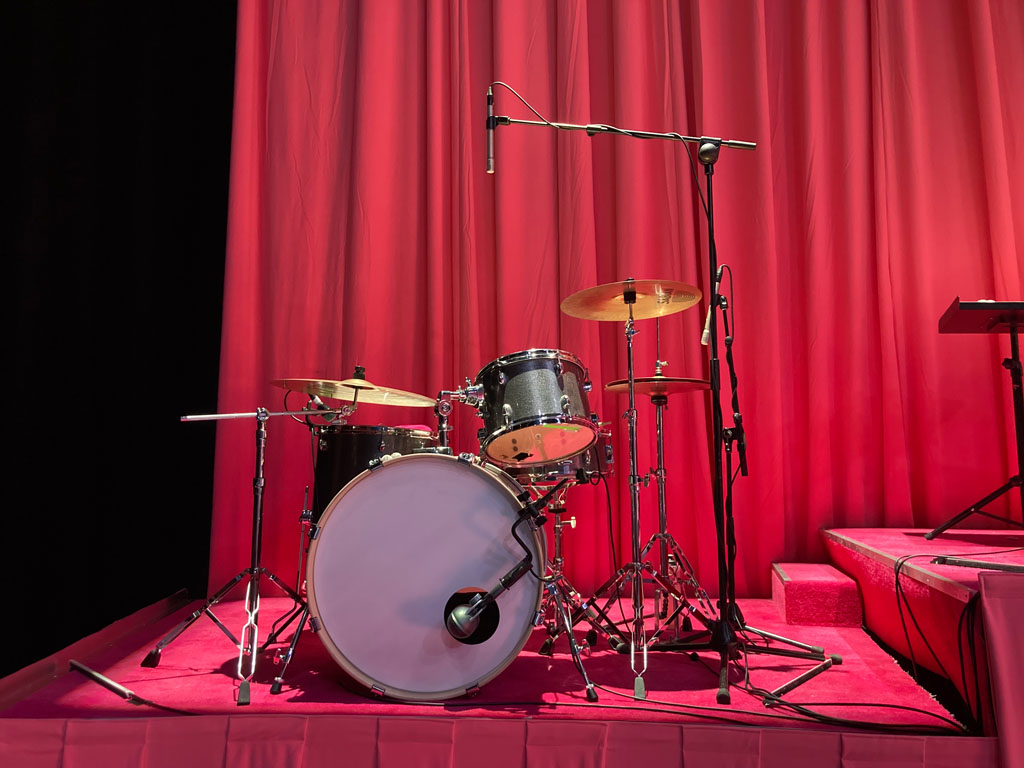
Because we require large multiples of each microphone, I have chosen popular models to avoid venues being unable to supply them. We use Shure SM81s for overheads and hi hats. Sennheiser e604 (or e904) for the snare and floor tom. Shure Beta52As for the kick drums. The sound of nine drum kits playing loudly sounds big, period, but having the close mic-ed drums helps to reinforce the compositional elements in quieter sections.
SPL (Sound Pressure Level) gets special mention here as it seems like the default worry for every venue and patron. Mention nine drum kits playing simultaneously and there is an expectation that everything is ear bleedingly loud all the time, but with drummers perched upon carpeted staging surrounded by heavy pink drapes in a large venue, and a dynamic music score, means the acoustic show isn’t continuously loud, and this grants greater control over how loud the show is mixed through the sound system. It also ensures the audience’s sound exposure levels are safe, with the amplified show usually metering at a continuous sound level (LAeq) of 82dB(A).
The show audio is mixed using Control Groups (CG) as this allows, for example, all the snares to be varied as a group. This is the same approach you might take to mix music theatre. It also allows the drum input channels to be spilled out together, such as all the kick drums, for EQ or compression duties. All drums pass through two parallel group channels (one uncompressed, the other heavily compressed) before exiting via the master buss. A master multiband compressor is set usually to the sound systems crossover frequencies, for tonal and dynamic control, before passing through a low ratio compressor with a long release time. I use the standard DiGiCo dynamics, EQs and effects. I would also say that the music mix works best with less compression applied. Drum parts are always exposed (unlike a regular band which has other instruments accompanying) so it’s easy to hear dynamics working and they can be mostly unnecessary if you have the balance set and a drummer’s performance is consistent.
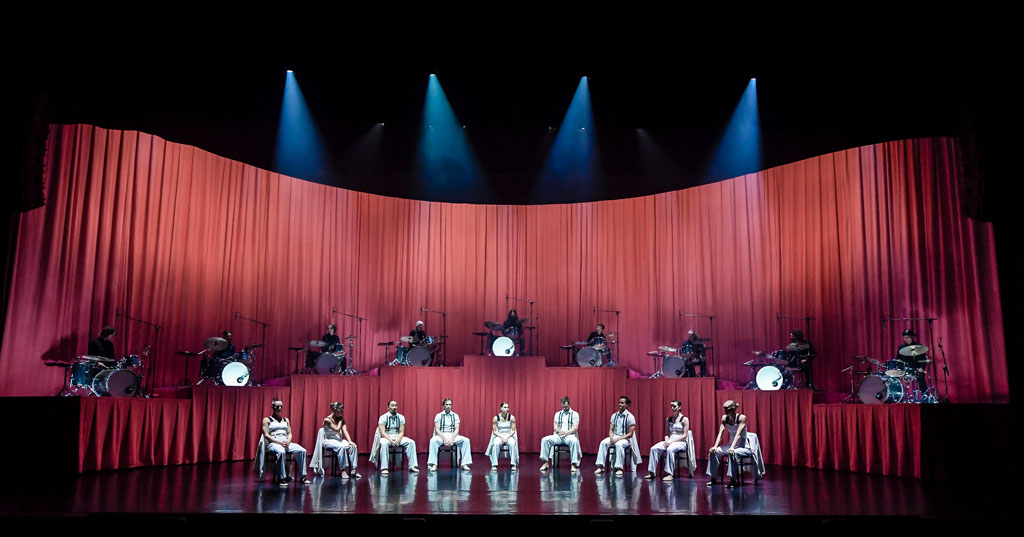
Robin was clear he didn’t want to apply a lot of time-based effects (reverb, delay) in the show. The effects we do use are standard music mix choices, one plate, one hall reverb, and a ping- pong delay. The use of effects is subtle, and the percentage applied depends on the venue.
Most Australian playhouse theatres have questionable acoustics; you’ll find a cavernous concrete space above the stage and audience, and a loud slap back from stage sound hitting the rear wall. Manifesto’s pink drapes help improve these lack lustre acoustics by limiting the amount of sound reflecting around the venue.
I mix off the main stereo buss and then matrix to the venue’s different speaker zones. Usually I am an advocate of live mixing music in mono as a way to try and ensure the mix is heard evenly across the venue. For Manifesto each of the nine drum kits are panned left to right as you see them on stage to help locate the sound source to their physical position. Phase, comb filtering, smearing, call it what you will, they are all an issue with so many sound sources and microphones on stage. I delay channels to compensate for phase issues, due to the varied drum positions across the stage and their interaction with the front of house sound system, using Smaart or Open Sound Meter. It’s usually much easier to do this with only one drum kit!
With any sound mixing, you have to make sense of the music to achieve a musical balance of sonic elements, and in this show, with an ensemble of nine drum kits it’s arguably of more importance than usual. At times, Manifesto’s dance and music are a familiar pulsing, repetitive, union of precision, and at other times there is fractured chaos. To mix this show you need to make sense of these extremes and interpret them to bring balance and continuity to the performance.
Above all the technical considerations, the skill of listening and acting upon your sense of what makes the music cohesive is probably the most important skill you can apply.
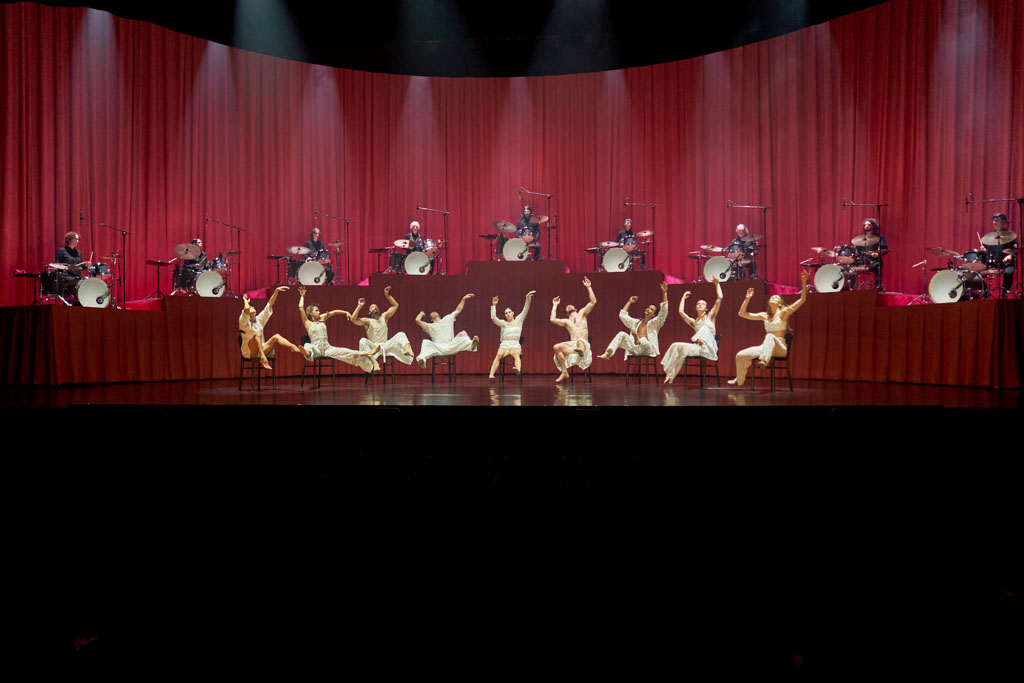
Subscribe
Published monthly since 1991, our famous AV industry magazine is free for download or pay for print. Subscribers also receive CX News, our free weekly email with the latest industry news and jobs.

